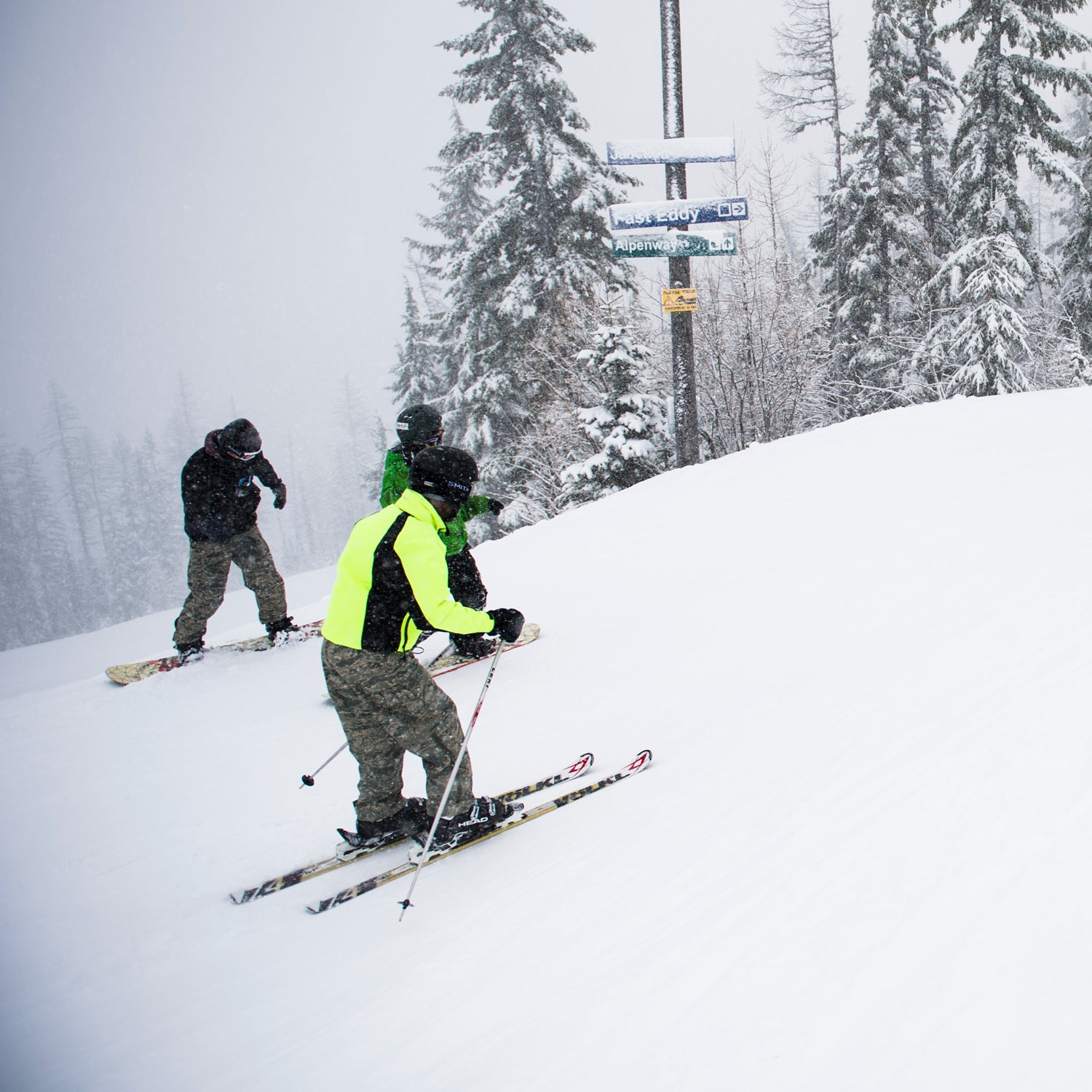Yesterday there was a fatal avalanche at Silver Mountain Ski Resort, a close neighbor to us in Kellogg, Idaho. Our deepest condolences go out to the avalanche victims and their friends and family. We have now had two separate avalanche accidents during the past week in and around our forecast area, totaling four deaths. The mountains are screaming at us to stay out of avalanche terrain. —
That report comes from my local avalanche center in west central Montana. News fromĚýacross the Idaho border is sparse, and we won’t know all the details until an investigation is completed in the coming weeks. What we do know is that eightĚýskiers were caught in an inbounds avalanche on open expert terrain at Silver Mountain, and that three of them died.
As is always the case with inbounds avalanche fatalities, the news was both tragic and shocking. Unlike more routine backcountry avalanche deaths, it was picked up by outlets like Ěýand . In 2020, few people expect skiers to die in avalanches at ski areas. We explained why this is the case last year,Ěýafter a similar tragedy hit New Mexico’s Taos Ski Valley. The digest version is that ever more effective avalanche mitigation makes fatal inbounds avalanches exceedingly rare. But as that article made clear, skiing inboundsĚýis never risk free. Whether they know it or not—and most do not—Western skiers live with this residual uncertainty. Ski patrol does everything in its means to open terrain safely, but inbounds avalanches still happen even after the patrol runs routes, throws bombs, and ski-cutsĚýslopes. This will never change. We assume that risk when we ski.Ěý
Some semantics help to drive this point home. Over the past 25 years, the ski industry has stopped using the term avalanche controlĚýin favor of avalanche mitigation.ĚýIt’s in part legalese, but the latter term is also more accurate, says Jackson Hole Mountain Resort’s head of snow safety, Mike Rheam. “It implies that we’re trying to mitigate riskĚýbut that we can’t eliminate it,” Rheam says. “Our savviest local skiers understand that, but most skiers don’t.” At another steep and deep area, Alta, Utah, patrollers even avoid the word mitigation. “We call it snow safety work,” says Andrew McCloskey, an Alta patroller for the past 17 years who’s also a skiĚýtester for şÚÁĎłÔąĎÍř. “And we make a point of letting skiers know that we have avalanche terrain. We do the best we can to mitigate the hazard, butĚýavalancheĚýscience isĚýimprecise. Ultimately, Mother Nature is in control.”
For ski areas, the greatest riskĚýoccurs in the early season or when mountains are opening new terrain after slow starts—that’s right now for Idaho, which is just seeing winter settle in. It’s during the time of accumulatingĚýsnow that a series of factors can circumvent attempts at mitigation. New snow falling on a thin snowpack that contains a persistent weakness—say, a rotten layer of sugar snow near the ground—and the opening of new terrain set the stage. Add skiers and you just mightĚýunleashĚýthe avalanche dragon.
If you want to completely ensure your safety in this one small part of the skiing risk continuum (remember: you’re more likely to suffocate in a tree well or get splatted by some out-of-control goon), the fix is to stay off higher-riskĚýterrain altogether. But that’s harder to do than you might think. The sweet spot for an avalanche releaseĚýis a 38 degree slope angle, which can be a challenging blue or a moderate black, depending on the resort. In fact, pretty much all the skiing that’s rated advanced to expert at your favorite Western ski area is technically avalanche terrain. Few are going to quit skiing that terrain because of the remote threat of an inbounds slide. For the skiing populace writ large, a newfound passion for powder and steeps only takes us deeper into avalanche country like the committing lines on Silver Mountain’s Wardner Peak or Taos’s Kachina—the sites of the fatal incidents.
While we assume the inherent risk, there are some things we can do to protect ourselves. Developing a mountain senseĚýis step one. Treating inbounds avalanche terrain like the backcountry during the early season and big storms is essential to that end. Just because your local avalanche center is careful to say that its forecasts don’t apply to the ski areas in your region, doesn’t mean you should tune them out if you’re skiing inbounds. If it’s high hazard in the backcountry and you’re in the midst of a heavy storm cycle, your mountain sense should tell you to ski the area differently. When I caught up with McCloskey from Alta the day after the Silver Mountain accident, he was on a chairlift in a storm. As he’s done every ski day for the past 17 years, he was wearing an avalanche transceiver. And he’d just asked a woman on the chair—a local from Salt Lake—if she was wearing one, too. Wearing a transceiver in avalanche country just makes sense. “At Alta we encourage people to wear beacons,” McCloskeyĚýsays. “Beacons are expensive but batteries are cheap. Get your money’s worth. You’re still in the mountains. Act like it.”
Next up, ski with a partner.ĚýBreak a leg or a spine, and it’s your partner who will be first on the scene. In the worst-case scenario, a friend might be able to identify the last point he saw you. In the best, he could ski directly to your exposed hand and start digging with a ski tail. “Being alone is poor style inbounds or out,” says longtime Alaska and Teton guide Doug Workman, who has skied with a transceiver inbounds since a skier died in a resort slide at Jackson in 2008. “Most avalanches that catch skiers don’t result in full burials. It could be a partner clearing your airway with his hand that saves your life.”Ěý
If your mountain sense is firing and the mountain just opened Gnar Bowl for the first time this season, adopt more of a backcountry protocol and devise a plan for each run. It takes all of ten seconds. That way, you know if a friend doesn’t show up at the rendezvous and might be inverted in a tree well. On such days, ski one at a time on big slopes, and consider carrying a light pack with your shovel and probe. That’s what the locals do in places like Jackson and Revelstoke where resort-accessed backcountry is often an option.ĚýĚý
Just as you would never ski out the gate of a big resort without the gear, training, and like-minded partners, you should take some ownership of your safety at the resort, too, and show the mountains the respect they deserve. Embracing the backcountry ethos inbounds and out—and refusing to ever ski a closed slope—is one bit of advice offered by Jackson HoleĚýpatrol director Drew Kneeland, who has skied into closed areas after the mitigation work is done only to find the holes left by avalanched skiers who barely escaped death for their poaching.Ěý
Play by the rules and keep your wits about you and you can at least increase your odds, which are already quite good—even as we mourn the skiers who died at Silver Mountain. Not that skiing with a beacon, shovel, probe, partner, and plan is a panacea. Large avalanches and deep deposits are deadly. “We’ve had one post-mitigation death in 40 years,” KneelandĚýsays. “şÚÁĎłÔąĎÍř the gates, we’ve had too many avalanches to count. Taking safety beyond mitigation has to start with the skier. If you’re skiing in avalanche terrain inbounds or out, pay attention when your avalanche center is putting out warnings. Get the equipment and the knowledge. Learn to identify all manner of hazards.ĚýWe only open terrain because we think it won’t avalanche, but we can never be sure.”Ěý
For my part, I was skiing in Montana about 130 miles from Silver Mountain at my adopted home hill the same day the slide caught the Idaho skiers. Like them, I was out with friends skiing terrain that had only recently opened, enjoying a foot of dense snow. I was thinking about avalanches that day, but not enough. The next morning—about an hour before my editor asked me to write this story—I read the first reports out of Idaho and sent a note to my skiing buddies saying we should be more cautious. We all should.Ěý


